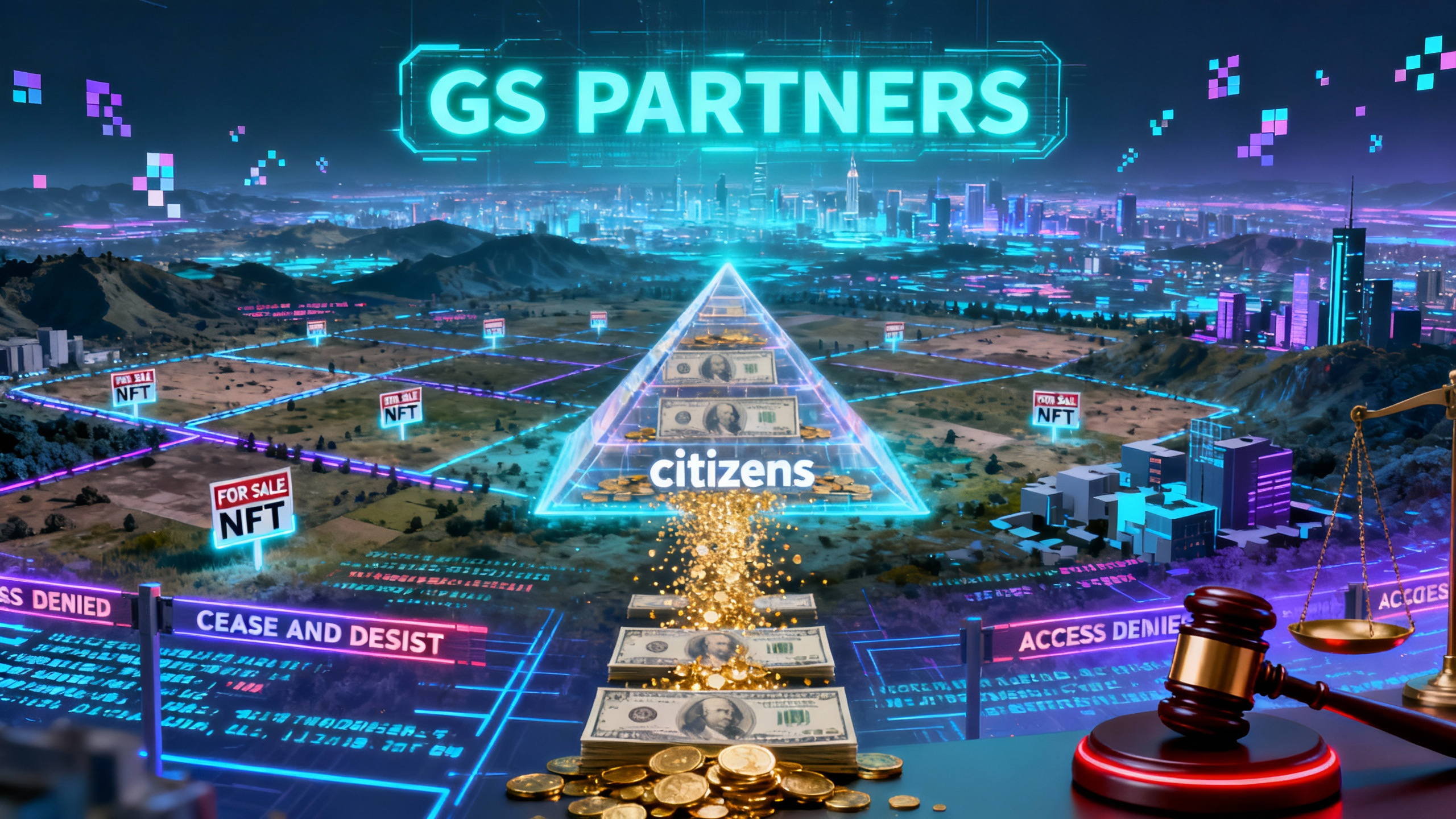GS Partners: A Look at Its Controversial Investment Model
GS Partners, known for promoting MetaCertificates and the G999 token, has been exposed by U.S. regulators as a fraudulent crypto investment scheme, resulting in multi-state settlements.
Comments

Introduction: A Cryptocurrency Ponzi Scheme in Disguise
Cryptocurrency platforms have revolutionized the world of investment, attracting millions of individuals seeking lucrative returns through digital assets, blockchain technology, and innovative business models. However, as the world of digital currencies grows, so too does the number of fraudulent schemes and Ponzi operations that exploit the hype around cryptocurrency. One such platform that epitomized the dangers of this unregulated space is GS Partners, a company that rose quickly to prominence before falling dramatically due to its unsustainable practices and Ponzi scheme-like operations.
GS Partners promised enormous returns to investors through products such as MetaCertificates and digital tokens like G999. It attracted thousands of individuals with its promises of exponential wealth, but as we’ll see, the reality was far from the promises made. By the time regulators stepped in, it was clear that GS Partners was less a legitimate business venture and more a carefully disguised Ponzi scheme, drawing comparisons to previous financial scams in both the crypto space and traditional financial markets.
This article explores the rise and fall of GS Partners, examining its business model, the legal actions taken against it, the investor losses, and the broader implications for the cryptocurrency market. Through this detailed exploration, we’ll uncover the red flags that investors missed, the regulators’ crackdown on the platform, and what lessons can be learned from GS Partners’ collapse.
The Beginning of GS Partners: How It Drew Investors In
The Promise of High Returns
GS Partners launched as an ambitious project in the world of cryptocurrency and blockchain. Its platform offered a series of high-yield investment opportunities through what it called MetaCertificates—financial products that promised weekly returns of up to 22%. The company marketed these certificates as a unique opportunity to earn high returns with little risk, a promise that naturally attracted many investors looking for quick profits in the burgeoning world of digital assets.
In addition to MetaCertificates, GS Partners also offered digital tokens—G999—which were marketed as the “next big thing” in blockchain technology. These tokens were promoted as an integral part of a virtual ecosystem, Lydian World, a metaverse-like platform where users could invest, stake, and earn rewards. According to GS Partners, investing in these tokens would not only yield high financial returns but would also place investors at the forefront of the digital world’s next great leap forward.
The company used a multi-level marketing (MLM) structure to draw in new investors. By recruiting others to join the platform, early adopters could earn commissions, which further incentivized the expansion of the platform. This strategy allowed GS Partners to build a vast network of investors who believed in its promised returns, fueling its rapid growth.
The G999 Token and Lydian World: Virtual Investments with Real Consequences
The GS Partners ecosystem also involved a virtual metaverse called Lydian World, where users could stake their G999 tokens and earn rewards. This feature was part of the broader narrative that GS Partners sold—an investment in a digital future that seemed both innovative and lucrative. Investors could use their G999 tokens to buy virtual property in the Lydian World, participate in the growth of the platform, and even benefit from the rise in the token’s value.
However, despite the glossy marketing and the allure of virtual investments, there was very little transparency about how Lydian World actually worked. The details behind the platform’s mechanics were vague, and there was no verifiable way to assess the actual profitability of these investments. As we will later learn, these virtual investments were largely unsupported by tangible assets or any real, verifiable growth—making it clear that the platform was far less innovative than it appeared.
The Red Flags: What Went Wrong at GS Partners
Unrealistic Returns and Lack of Transparency
The first and most significant red flag that GS Partners raised was its promise of unrealistically high returns. While high returns are often associated with high risks in legitimate investment markets, the returns promised by GS Partners were too good to be true. Promising 22% returns per week was not only highly improbable but also indicative of a Ponzi scheme model, where returns to early investors are paid from the investments of later participants rather than from actual profit-making activities.
Furthermore, GS Partners provided very little transparency regarding the operation of its platform. The company failed to disclose how its MetaCertificates worked, how profits were generated, or what safeguards were in place to protect investor funds. The lack of transparency surrounding the platform’s operations and the absence of verifiable audits should have raised alarms for anyone familiar with investment markets, but the allure of quick returns often clouds investors’ judgment.
Multi-Level Marketing (MLM) Model: A Classic Ponzi Scheme Structure
Another significant issue with GS Partners was its reliance on a multi-level marketing (MLM) model, where investors were encouraged to recruit new participants in exchange for commissions. This structure incentivized individuals to promote the platform to others, which is a common tactic used by Ponzi schemes. The success of the scheme depended on the continuous influx of new investors to keep the platform running.
MLM-based systems typically rely on the investment of new recruits to pay returns to earlier investors, which is not a sustainable model. As more and more people were recruited, the company expanded rapidly, but eventually, the scheme began to fail when the number of new investors slowed down. This is a classic trait of a Ponzi scheme: an unsustainable cycle of promises and payouts that eventually collapses under its own weight when new investment slows or stops.
Global Regulatory Backlash: Warnings and Legal Actions
FSCA Warning in South Africa
In November 2023, the Financial Sector Conduct Authority (FSCA) in South Africa issued an official warning about GS Partners. The FSCA stated that GS Partners was not registered to offer any financial services or products within the country and had not been authorized to operate by the relevant regulatory authorities. The warning also highlighted the unrealistic returns promised by the platform and the absence of proper licensing.
This was the first major regulatory warning against GS Partners, and it set the stage for the increasing pressure the company would face from financial regulators around the world. The FSCA’s warning was part of a broader trend in which regulators began scrutinizing the cryptocurrency sector for fraudulent schemes that promised high returns without adequate oversight or protection for investors.
Texas Takes Action: A Multi-State Investigation
In early 2024, the Texas State Securities Board launched an emergency enforcement action against GS Partners. The state authorities alleged that the company was offering unregistered securities and operating a Ponzi scheme. Texas officials emphasized that GS Partners was using multi-level marketing tactics to recruit new investors and pay returns to older investors, rather than generating legitimate profits.
The Texas authorities filed a cease and desist order, demanding that GS Partners halt its operations within the state. Additionally, the company was ordered to return any funds obtained through fraudulent activities. This legal action was part of a multistate investigation into GS Partners’ practices, which ultimately led to a settlement requiring the company to refund its investors.
Legal Actions in Other Jurisdictions
As the regulatory crackdown on GS Partners intensified, other jurisdictions, including California, Canada, and Australia, took similar actions. Regulatory bodies in these countries issued their own warnings about the platform, urging investors to avoid participating in the scheme. GS Partners, by this point, had rebranded itself multiple times, including a name change to GSPro, in an attempt to evade the growing legal pressure.
However, these rebranding efforts failed to protect the company from the inevitable legal consequences. Financial regulators around the world were increasingly aggressive in their efforts to shut down GS Partners and return funds to affected investors.
The Collapse: The End of the Road for GS Partners
Despite its attempts to rebrand and avoid regulatory action, GS Partners eventually collapsed. In late 2024, the company announced that it would be shutting down its operations, with no explanation provided for the sudden cessation. By then, investors had become increasingly wary of the platform, and many had already begun to withdraw their funds, leading to the platform’s financial implosion.
GS Partners, which had once been promoted as a cutting-edge platform for digital investment, had become a failed Ponzi scheme, leaving behind thousands of defrauded investors who had been promised high returns that were never delivered. The collapse of the platform serves as a stark reminder of the risks associated with unregulated and poorly understood investments.
Investor Impact: The Emotional and Financial Toll
The collapse of GS Partners had a devastating impact on its investors. Many individuals who had trusted the platform with their savings were left with nothing. Some investors had invested their life savings, hoping for financial freedom, only to find themselves with empty wallets and broken dreams.
The emotional toll was just as severe, as investors struggled to come to terms with the reality of being scammed. Many were left questioning their own judgment and feeling betrayed by the false promises made by GS Partners. This experience highlights the psychological impact of financial fraud, as victims grapple not only with financial losses but also with the emotional burden of being deceived.
However, some investors were able to file claims for reimbursement as part of the regulatory settlements in the U.S. and other countries. These efforts to secure refunds offer a glimmer of hope to those who had fallen victim to the scam, although not all investors were able to recover their losses.
What Investors Can Learn from the GS Partners Saga
The collapse of GS Partners offers several key lessons for investors, particularly in the world of cryptocurrency and blockchain investments:
1. Do Your Research
Before investing in any platform, it’s crucial to conduct thorough research. Check whether the platform is regulated, and if not, question why that is the case. Look for red flags such as unreasonably high returns, lack of transparency, and the use of multi-level marketing tactics.
2. Be Wary of Promises of High Returns
High returns with little to no risk are a classic warning sign of a Ponzi scheme. Always be cautious of investment opportunities that seem too good to be true.
3. Understand the Risks
Every investment carries some level of risk. Ensure that you fully understand the potential for both gains and losses before committing funds to any platform. If you don’t fully understand how a platform works, it’s best to avoid it.
4. Report Suspicious Activities
If you come across a potential scam, report it to your local financial regulatory authority. Governments and regulators have tools to investigate and shut down fraudulent schemes.
Conclusion: The Need for Regulatory Oversight and Investor Education
The fall of GS Partners is a cautionary tale for investors in the cryptocurrency space. While digital currencies and blockchain technologies offer exciting opportunities, they also present unique risks. The lack of regulation and the rise of fraudulent schemes highlight the need for stronger oversight in the crypto sector.
As cryptocurrency continues to grow, it’s essential for investors to remain vigilant, conduct thorough research, and understand the risks involved. The GS Partners case serves as a critical reminder that even in the world of digital assets, scams can run rampant, and investors must be proactive in protecting themselves.
By learning from the mistakes of GS Partners, both investors and regulators can work together to build a safer, more transparent financial ecosystem for the future.

Fact Check Score
0.0
Trust Score
low
Potentially True


Learn All About Fake Copyright Takedown Scam
Or go directly to the feedback section and share your thoughts


-
Mr. Pacho Casino Delays Withdrawals and Blocks ...
Introduction In the glittering yet treacherous realm of online casinos, sites like Mr. Pacho lure players with flashy promotions, diverse slots, and promises of quick riches. Operating as... Read More-
Monsterwin Customers Frustrated by Poor Support...
Introduction In the age of online gaming and digital entertainment, platforms like Monsterwin.com have gained popularity among users looking for an exciting gaming experience. However, in... Read More-
Mr Rex Casino: Withdrawal Delays and Poor Support,
Introduction In the fast-paced world of online betting, platforms like Mr Rex promise excitement, big wins, and seamless gameplay. Launched as a vibrant sportsbook and casino hybrid, Mr R... Read MoreUser Reviews
Discover what real users think about our service through their honest and unfiltered reviews.
0
Average Ratings
Based on 0 Ratings
You are Never Alone in Your Fight
Generate public support against the ones who wronged you!
Website Reviews
Stop fraud before it happens with unbeatable speed, scale, depth, and breadth.
Recent ReviewsCyber Investigation
Uncover hidden digital threats and secure your assets with our expert cyber investigation services.
Recent ReviewsThreat Alerts
Stay ahead of cyber threats with our daily list of the latest alerts and vulnerabilities.
Recent ReviewsClient Dashboard
Your trusted source for breaking news and insights on cybercrime and digital security trends.
Recent Reviews